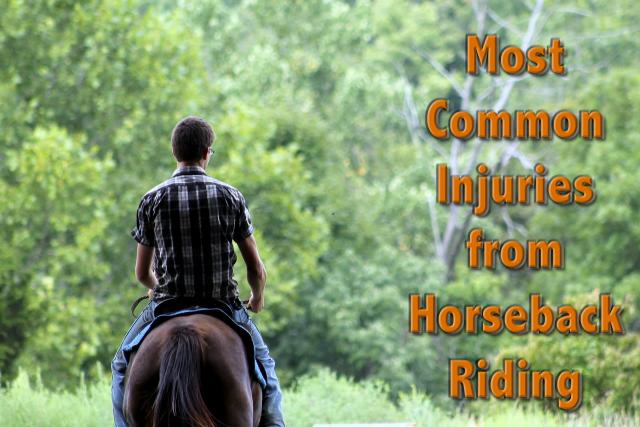Most Common Injuries from Horseback Riding
 Horses are one of man’s best companions. They are not only useful, loving, and beautiful to gaze upon but they also provide us with hours of fun, as any horseback riding enthusiast will tell you. Horseback riding is one of the world’s oldest methods of transportation and will live on as long as there are riders in the world. As with any activity that involves skill with such a large and majestic animal, there are risks involved. Although these risks may be rare in occurrence, when they happen, they can be quite devastating. According to the National Electronic Injury Surveillance Survey (NEISS), an estimated 78,499 people were treated in hospital emergency rooms for horseback riding injuries in 2009. Among the injuries experienced by riders, they seem to take place in the upper extremities or to the head and the face. The most common form of injury from horseback riding is damage or injury to the soft tissue. Other injuries include fractures, shoulder injuries (such as dislocation), concussions, and damage to the spine and central nervous system. This may all sound very terrifying, however, compared to the vast amount of the population who ride on horseback, as well as the frequency and popularity of the activity, the risks are fairly low considering the duration of mankind’s liaison with horses. There are other factors to consider that may correlate with a rider becoming injured. Factors such as lack of training by the rider, lack of understanding of how powerful and strong horses can be and their temperament, not staying aware of their surroundings, or lack of proper riding equipment or gear. Riding a horse requires good guidance and instruction from a trained rider. It is also important to know if you are in the right physical condition to be riding a horse. Selecting the right size and type of horse for the individual rider is also crucial. These facets are important since prevention is way easier than dealing with injuries. Here we will examine the most common minor, treatable injuries and afflictions, as well as to how to remedy them so that you can literally “get back in the saddle again.”
Horses are one of man’s best companions. They are not only useful, loving, and beautiful to gaze upon but they also provide us with hours of fun, as any horseback riding enthusiast will tell you. Horseback riding is one of the world’s oldest methods of transportation and will live on as long as there are riders in the world. As with any activity that involves skill with such a large and majestic animal, there are risks involved. Although these risks may be rare in occurrence, when they happen, they can be quite devastating. According to the National Electronic Injury Surveillance Survey (NEISS), an estimated 78,499 people were treated in hospital emergency rooms for horseback riding injuries in 2009. Among the injuries experienced by riders, they seem to take place in the upper extremities or to the head and the face. The most common form of injury from horseback riding is damage or injury to the soft tissue. Other injuries include fractures, shoulder injuries (such as dislocation), concussions, and damage to the spine and central nervous system. This may all sound very terrifying, however, compared to the vast amount of the population who ride on horseback, as well as the frequency and popularity of the activity, the risks are fairly low considering the duration of mankind’s liaison with horses. There are other factors to consider that may correlate with a rider becoming injured. Factors such as lack of training by the rider, lack of understanding of how powerful and strong horses can be and their temperament, not staying aware of their surroundings, or lack of proper riding equipment or gear. Riding a horse requires good guidance and instruction from a trained rider. It is also important to know if you are in the right physical condition to be riding a horse. Selecting the right size and type of horse for the individual rider is also crucial. These facets are important since prevention is way easier than dealing with injuries. Here we will examine the most common minor, treatable injuries and afflictions, as well as to how to remedy them so that you can literally “get back in the saddle again.”

